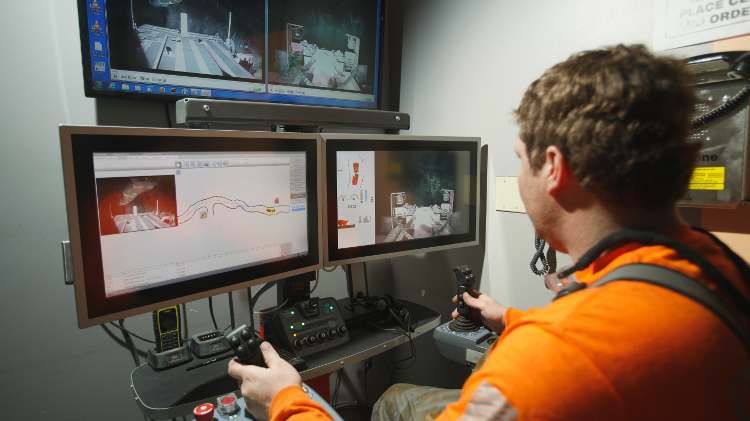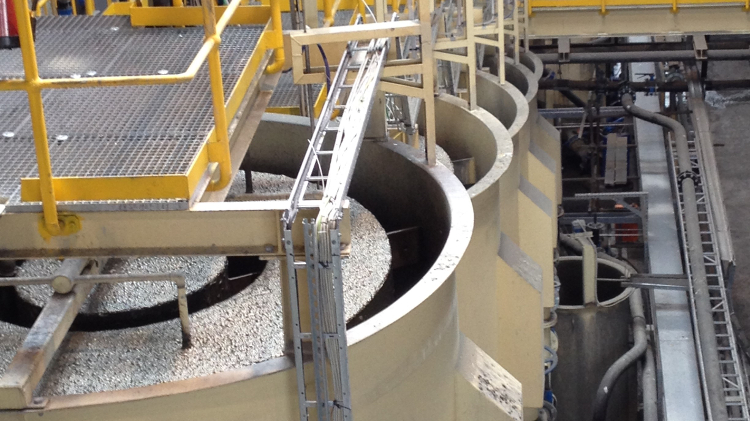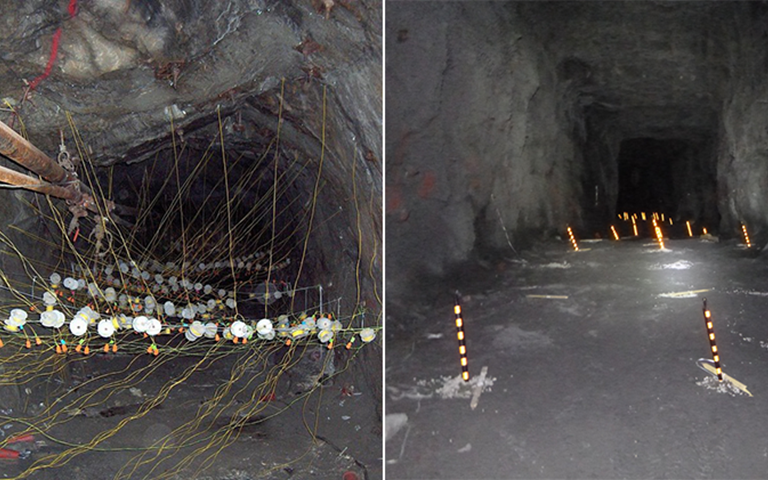Left: a drift at Goldcorp's Musselwhite mine loaded for blasting using traditional methods. Right: a drift at Musselwhite loaded for blasting with Orica's WebGen wireless system. Courtesy of Orica
In a set of trials at Musselwhite mine beginning in late 2016, Goldcorp tested a new mining method to reduce dilution in its production stopes with Orica’s WebGen 100 wireless detonators. “It’s a game changer for the long term,” said Holly Robinson, senior operations planner at Musselwhite.
Musselwhite, located in northern Ontario, originally used a modified Avoca method in retreats without secondary access. In this method, panels are backfilled from the retreat end before some fill is removed (a void pull) to provide the void space for the next blast and to prevent the unconsolidated fill from mixing with newly blasted ore. But as the mine increased in depth and strike length in recent years, dilution began straying well above the 15 per cent range expected, and up to 30 per cent in some areas.
Steve Piercey, the senior underground blasting specialist at Orica, had been working with Musselwhite even before the first production blast in 1997. He thought the company’s new WebGen system could help with the mine’s dilution problem. Orica had been developing its wireless blast initiation technology since 2009, decreasing the size of the detonator-primer assemblies and certifying its safety. What they needed was a real-life evaluation in a working mine.
Not exactly Wi-Fi
The WebGen system, which Orica offers as a service rather than a product, uses an ultra-low frequency magnetic induction wave that can travel through water, air, rock, backfill and even bog, said Piercey. The magnetic induction wave is transmitted by an antenna at around 1,800 hertz, and received by disposable receivers (DRXs) in each borehole. The portable four-lobe transmission antenna being used by Orica at Musselwhite has a range of around 300 metres, while another, more permanent 40-metre single-loop antenna has a range exceeding one kilometre.
Each 51 mm-diameter, 320 mm-long DRX has a tri-axis antenna array to receive the signal, supporting any blasthole orientation. “There’s also all of the electronics inside the DRX for the communications and all of the deciphering,” said Piercey. The non-explosive DRX plugs in to a version of Orica’s i-kon III electronic detonator, with a unique connector for the DRX. The i-kon detonator then attaches to a pentolite booster for a total unit length of 490 mm. “It’s the same detonator that we would use in a wired system, with a different plug,” explained Piercey.
Related: Galantas Gold receives “anti-terrorism cover” for blasting work at Omagh mine, highlighting decades-old explosives rules in Northern Ireland
Following the blast plan, each DRX is encoded with the Group ID for its blast, and each i-kon detonator with a delay time, just prior to being loaded into the blastholes. A standalone Code Management Computer (CMC) – a tablet wiped of other software – is uploaded with a CSV file from Orica’s blast design software. The CMC assigns the encrypted firing codes and delay timing into a preload blast file. A handheld encoder takes the data from the CMC and encodes each DRX and i-kon.
Three separate codes make up the Group ID, and all three must be received from the transmitter to initiate a blast. First, a wake-up code activates the appropriate DRXs from sleep mode. “Any DRX with that common Group ID will wake up when they hear their wake-up call,” explained Piercey. “But a blast sleeping right next to it that you want to blast in four days’ time will have its own unique Group ID.” Next, the activated DRXs receive an arm code, which calibrates and synchronizes the units. Finally, following the mine central blasting protocol, the fire signal is sent, firing each detonator according to its programmed delay time. Other DRXs, having not received their wake-up code, remain dormant in their blastholes, ready for subsequent blasts.
“For all of the wonderful things we were able to do with electronic blasting, we were still encumbered by wires,” said Piercey. “Now we have a truly commercial system that is 100 per cent wireless.”
Test the tech
In the new method designed by Orica and trialled at Musselwhite, a temporary rib pillar (TRP) is left where the unconsolidated backfill meets the ore, holding the backfill in place until after the mass blast. Vitally, the TRP also minimizes sloughing from the hanging wall by reducing the exposed strike length. “The rib pillar literally makes the hydraulic radius of the opening smaller,” said Musselwhite chief engineer Billy Grace. “We take a stope that’s a size that we know would be very reasonable with dilution, and then the rib pillar keeps that opening stable until we’re done mucking it.” Once the mass blast is mucked, the TRP can be blasted using the wireless detonators, and the TRP ore mucked.
 Courtesy of Orica
Courtesy of Orica
The WebGen system, Grace said, is the key enabling technology. “If we didn’t have the wireless technology, we’d somehow have to connect the wire from that TRP on the far side of the mass blast all the way over to the retreat side. No matter how well you protect it, there’s always the risk that that wire would be severed.”
Trying the technology at Musselwhite was “a no-brainer” for Orica, said Piercey. “We actually developed this TRP Avoca mining method with [the wireless detonator] using Musselwhite as the model mine back in 2010.”
The blasting company made it easy for Musselwhite to agree, added Grace. “Orica actually has quite a strong project charter process that it went through, and a really great peer review process among its senior people. I think they were stacking the cards with Musselwhite,” he said. “We had high confidence going into everything we did with them.”
In the first evaluations, Musselwhite saw a remarkable 93 per cent reduction in dilution. It also spent 33 per cent fewer days mucking, and mucked an average of 27 per cent more tonnes per day. Trucks even hauled 15 per cent more tonnage per load compared to trucks loaded at conventional stopes, due to better fragmentation.
“We didn’t think it would improve as much as some of the case study areas proved,” admitted Robinson. The trial was so successful that Musselwhite immediately carried on incorporating wireless blasting and the TRP Avoca method into its daily operations.
“Probably half our blasts are associated with a wireless sequence at this point,” said Grace. “The improvements we saw [during the trial] haven’t started to creep back towards normal in these TRP stopes. They have been sustained as we continue to do more.”
All the possibilities
The TRP Avoca method is not the only method enabled by wireless blasting, either. One option Musselwhite is looking at is loading multiple blasts with wireless detonators in advance, to eliminate the loading cycle. “We might take, say, 10 blasts and load them all with wireless detonators,” said Grace. “So we’d fire the first one, muck, fill, and then we’re immediately ready to fire again without going through the loading cycle. There’s a bit of upfront time investment, but once it’s set up, it allows a mining front to move quite quickly.”
Other possibilities are temporary uphole rib pillars, to improve recovery along the upper plunge of Musselwhite ore zones, and a reverse throw retreat concept, using sequential blasts to throw muck to the drawpoint.
“It has really changed the way we think about planning and what’s possible with longhole blasting at Musselwhite,” Grace said.
“Ultimately, the WebGen system provides a way of loading something that you’re no longer going to have access to after taking your primary blast,” said Robinson. “It’s completely opened things up. We’re not just doing TRP; now that we have this tool in our toolbox, it’s getting applied in other ways.”
Orica is already working on the next-generation WebGen 200, a smaller version. “If they can get the technology into a smaller package, you could remote load development faces,” said Robinson. “From a safety standpoint, this is a huge win for the industry as we will actually be able to remove people from the risks associated with working at development faces.”





